Project Log: Wednesday, November 12, 2014
The boat had been eyeing me balefully over the past
weeks and months, feeding my guilty conscience on a
daily basis as I went about my other business in the
shop. With my schedule starting to free up and
return to something approaching normal, I could once
more turn to some of the final jobs on board.
|
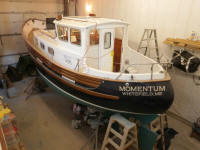 |
One of the last major details remaining in the cabin
(there were plenty of smaller details) was the cabin
sole, which I'd waited on as long as possible to avoid
unnecessary wear and tear or damage to the new sole
during other construction. Now, I was
anxious to install and finish the sole and start to
really wrap things up.
Long ago, I'd set aside three wide Khaya boards (an
African mahogany species) for the sole material. I
used this species for the forward cabin ceiling (hull
liner) as well. Two of the boards were over 15"
wide, and the third was just over 12". |
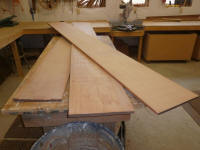 |
These boards came to me D3S (dimensioned 3 sides), but
the surface was pretty rough, with some grain tearout
from the industrial planers at the wood supplier.
Normally, I'd have resigned myself to several hours'
worth of sanding to prepare this material for use, but
I'd recently acquired a new planer for the shop, and I'd
found that its "finishing" setting, combined with new
blades, produced a glass-like surface more than adequate
enough for a cabin sole, or most other trim work.
To begin, I spent 30 minutes changing the blades on the
machine, which blades I'd recently killed during another
planing project on another boat.
Since two of the boards were too wide to send through
the planer, I cut each of the three pieces (the 12" one
would have fit, but I chose to cut it as well)
lengthwise, taking into account the final width of my
cabin sole planks (2"). Then, I ran all the boards
through the planer, taking off just a little material
(1/32" or under) on the finishing setting on both sides.
This cleaned up the planks very nicely. I trimmed
the ends to square them and remove any checking or
roughness. |
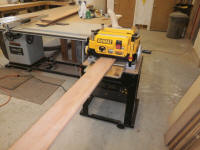

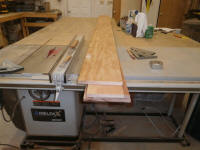 |
Now, I cut each of the six boards into a series of 2"
wide blanks. |
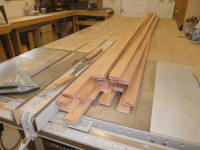 |
With a router, I milled small chamfers on each of the
four long edges of the new planks. These would
produce a small V-groove when I installed the planks and
help offset any minor plank thickness differences or
other installation inconsistencies, and provide a little
textured appearance to the sole. |
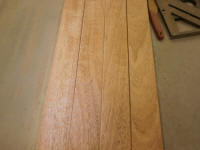
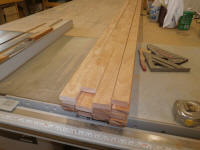 |
Finally, I cut each section into two 1/4" thick planks,
one from each side of the original blank. With the
edge detail already milled, and the smooth surface from
the planer, these were now ready for installation. |
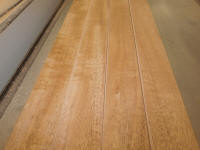
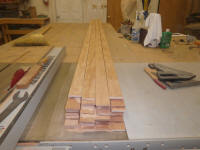 |
The cabin sole substrate was nice and flat, with mostly
square edges: no hull curvature to work around, or
anything time-consuming of that sort. |
 |
To begin installation, I started with a scrap of the
sole material, and used a saw and chisel to cut away the
bases of various corner and edge trims around the cabin,
which would allow the sole to slip beneath the trim and
streamline installation. |
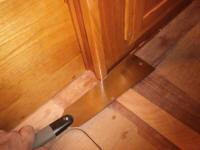
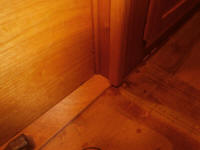
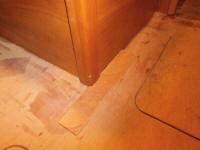
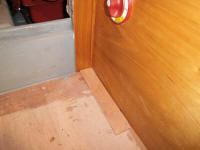 |
My "king plank", as it were, would run along the inboard
edge of the port settees, roughly on the centerline of
the boat. This plank, and the longer one that
would go just to starboard, would register all other
planks and define the appearance of the whole sole and
register the eye to those structures that were supposed
to be straight and in alignment (and, for the most part,
were). So I made a measurement and cut one of the
new planks to length, and dry-fit it in position right
over all the cabin sole hatches, marking its position
with a pencil in all areas. |
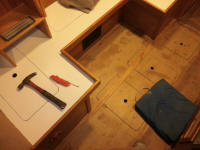
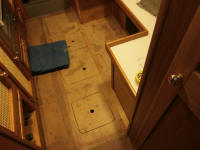 |
It was growing late, but I decided to install the first
plank now, as it'd give me a solid basis from which to
work off next time. Removing the hatches, I
installed the plank right over the open spaces for the
moment, since I needed the full length of the plank to
ensure that the installation was straight and true.
I'd trim off the excess in the openings later. I
installed the plank with glue and stainless brads, and
left it to dry overnight. |
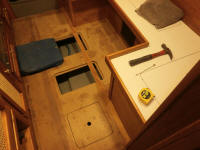
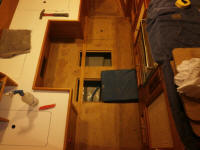 |
| |
Total Time Today: 4.5 hours
|
<
Previous |
Next > |
|
|




















